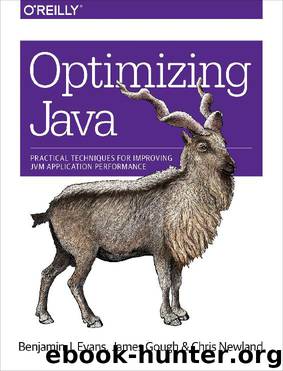Optimizing Java by Chris Newland & James Gough & Benjamin J Evans

Author:Chris Newland & James Gough & Benjamin J Evans [Chris Newland]
Language: eng
Format: epub
Publisher: O'Reilly Media, Inc.
Published: 2018-04-29T21:00:00+00:00
Comparing AOT and JIT Compilation
AOT compilation has the advantage of being relatively simple to understand. Machine code is produced directly from source, and the machine code that corresponds to a compilation unit is directly available as assembly. This, in turn, also offers the possibility of code that will have straightforward performance characteristics.
Offset against this is the fact that AOT means giving up access to valuable runtime information that could help inform optimization decisions. Techniques such as link-time optimization (LTO) and a form of PGO are now starting to appear in gcc and other compilers, but they are in the early stages of development compared to their counterparts in HotSpot.
Targeting processor-specific features during AOT compilation will produce an executable that is compatible only with that processor. This can be a useful technique for low-latency or extreme performance use cases; building on the exact same hardware as the application will run on ensures that the compiler can take advantage of all available processor optimizations.
However, this technique does not scale: if you want maximum performance across a range of target architectures, you will need to produce a separate executable for each one.
By contrast, HotSpot can add optimizations for new processor features as they are released and applications will not have to recompile their classes and JARs to take advantage of them. It is not unusual to find that program performance improves measurably between new releases of the HotSpot VM as the JIT compiler is improved.
At this point, let’s address the persistent myth that “Java programs can’t be AOT-compiled.” This is simply not true: commercial VMs that offer AOT compilation of Java programs have been available for several years now and in some environments are a major route to deploying Java applications.
Finally, starting with Java 9 the HotSpot VM has begun to offer AOT compilation as an option, initially for core JDK classes. This is an initial (and quite limited) step toward producing AOT-compiled binaries from Java source, but it represents a departure from the traditional JIT environments that Java did so much to popularize.
Download
This site does not store any files on its server. We only index and link to content provided by other sites. Please contact the content providers to delete copyright contents if any and email us, we'll remove relevant links or contents immediately.
Deep Learning with Python by François Chollet(12866)
Hello! Python by Anthony Briggs(10118)
The Mikado Method by Ola Ellnestam Daniel Brolund(10010)
OCA Java SE 8 Programmer I Certification Guide by Mala Gupta(9979)
Dependency Injection in .NET by Mark Seemann(9514)
Algorithms of the Intelligent Web by Haralambos Marmanis;Dmitry Babenko(8521)
Grails in Action by Glen Smith Peter Ledbrook(7880)
Test-Driven iOS Development with Swift 4 by Dominik Hauser(7851)
The Well-Grounded Java Developer by Benjamin J. Evans Martijn Verburg(7767)
Becoming a Dynamics 365 Finance and Supply Chain Solution Architect by Brent Dawson(7701)
Microservices with Go by Alexander Shuiskov(7453)
Practical Design Patterns for Java Developers by Miroslav Wengner(7380)
Test Automation Engineering Handbook by Manikandan Sambamurthy(7320)
Angular Projects - Third Edition by Aristeidis Bampakos(6746)
Secrets of the JavaScript Ninja by John Resig Bear Bibeault(6631)
The Art of Crafting User Stories by The Art of Crafting User Stories(6244)
NetSuite for Consultants - Second Edition by Peter Ries(6185)
Demystifying Cryptography with OpenSSL 3.0 by Alexei Khlebnikov(5996)
Kotlin in Action by Dmitry Jemerov(5295)
